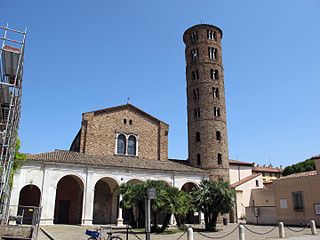 W
WThe Basilica of Sant'Apollinare Nuovo is a basilica church in Ravenna, Italy. It was erected by the Ostrogothic king Theodoric the Great as his palace chapel during the first quarter of the 6th century. This Arian church was originally dedicated in 504 AD to "Christ the Redeemer".
 W
WThe Augustaion or, in Latin, Augustaeum, was an important ceremonial square in ancient and medieval Constantinople, roughly corresponding to the modern Aya Sofya Meydanı. Originating as a public market, in the 6th century it was transformed into a closed courtyard surrounded by porticoes, and provided the linking space between some of the most important edifices in the Byzantine capital. The square survived until the late Byzantine period, albeit in ruins, and traces were still visible in the early 16th century.
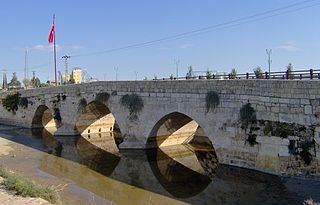 W
WBaç Bridge is a bridge in Tarsus in Mersin Province, Turkey
 W
WThe Basilica of San Vitale is a late antique church in Ravenna, Italy. The 6th century church is an important surviving example of early Christian Byzantine art and architecture. It is one of eight structures in Ravenna inscribed on the UNESCO World Heritage List. Its foundational inscription describes the church as a basilica, though its centrally-planned design is not typical of the basilica form. The Roman Catholic Church has designated the building a "basilica", an honorific title bestowed on exceptional church buildings of historic and ecclesial importance.
 W
WThe Basilica of Sant' Apollinare in Classe is a church in Ravenna, Italy, consecrated on 9 May 549 by the bishop Maximian and dedicated to Saint Apollinaris, the first bishop of Ravenna and Classe. An important monument of Byzantine art, in 1996 it was inscribed with seven other nearby monuments in the UNESCO World Heritage List, which described it as "an outstanding example of the early Christian basilica in its purity and simplicity of its design and use of space and in the sumptuous nature of its decoration".
 W
WThe Basilica of St. John was a basilica in Ephesus. It was constructed by Justinian I in the 6th century. It stands over the believed burial site of John the Apostle. It was modeled after the now lost Church of the Holy Apostles in Constantinople.
 W
WBerat Castle, also referred to as the Citadel of Berat and castle quarter, is a fortress overlooking the town of Berat, Albania. It dates mainly from the 13th century and contains many Byzantine churches in the area and Ottoman mosques. It is built on a rocky hill on the left bank of the river Osum and is accessible only from the south. It is situated at an elevation of 214 metres (702 ft).
 W
WThe Castle of Mytilene, also Fortress of Mytilene, is located in Mytilene on the Greek island of Lesbos, North Aegean. It is maintained in good condition and is one of the largest castles in the Mediterranean covering an area of 60 acres. The first castle on the site may have been erected during the time of Justinian I. The 6th-century castle may have been built on top of an already existent fortress. In the late Middle ages, the castle was the residence of Francesco I Gattilusio and his successors, especially the tower known today as the Queen's Tower. There is also strong evidence that the original acropolis on the site may have included a sanctuary to Demeter, Kore and Cybele.
 W
WThe Column of Justinian was a Roman triumphal column erected in Constantinople by the Byzantine emperor Justinian I in honour of his victories in 543. It stood in the western side of the great square of the Augustaeum, between the Hagia Sophia and the Great Palace, and survived until 1515, when it was demolished by the Ottomans.
 W
WDajti Castle is a 1.12 hectares archaeological site in Albania, comprising the ruins of a Roman fortification and several dwellings. It belongs to late antiquity, probably having been built over Illyrian foundations. It lies at 1,200 metres (3,900 ft) altitude on top of a hill, west-side of Mount Dajti, close to Tirana. It was discovered in 1963 and eventually was inscribed in the list of the Cultural Monuments of Albania. In 2008 a three-year restoration project began, aiming to conduct further archaeological searching and surveys and to improve the nearby infrastructure for visitors and tourists.
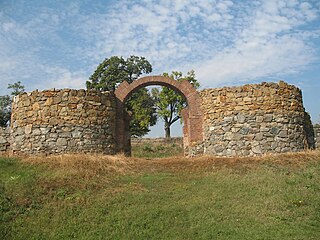 W
WThe Diana Fortress is a Roman castrum built in 100-101 AD, located in Kladovo, in eastern Serbia.
 W
WThe Didymoteicho Fortress or Castle, is an ancient and medieval hilltop citadel complex in the town of Didymoteicho, Eastern Macedonia and Thrace, Greece. It has been an important landmark since ancient times due to the strong fortification surrounding it. The castle is accompanied by several myths, one of the most famous is that of the Forty Arches, and is where Charles XII, King of Sweden, is said to have been imprisoned by the Turks.
 W
WDropull is a municipality and a predominantly Greek-inhabited region in Gjirokastër County, in southern Albania. The region stretches from south of the city of Gjirokastër to the Greek–Albanian border, along the Drino river. The region's villages are part of the Greek "minority zone" recognized by the Albanian government, in which live majorities of ethnic Greeks.
 W
WEchinus or Echinos was a town and polis of Phthiotis or of Malis in ancient Thessaly, situated upon the Malian Gulf, between Lamia and Larissa Cremaste, in a fertile district. It was said to derive its name from Echion, who sprang from the dragon's teeth. Demosthenes says that Echinus was taken by Philip II of Macedon, the father of Alexander the Great, from the Thebans. Philip II granted the town to the Malians in 342 BCE. From c. 235 BCE, it was part of the Aetolian League until 210 BCE, when it was captured by Philip V of Macedon, after a siege of some length. The Romans captured the city in 193 BCE and gave it back to the Malians in 189 BCE. Strabo mentions it as one of the Grecian cities which had been destroyed by an earthquake.
 W
WThe Frourio Hill is the historical acropolis of the city of Larissa, Greece. It was the citadel of the city in antiquity as well as in Byzantine times, and features a number of important archaeological sites.
 W
WHagia Sophia, officially the Holy Hagia Sophia Grand Mosque, and formerly the Church of Hagia Sophia, is a Late Antique place of worship in Istanbul, designed by the Greek geometers Isidore of Miletus and Anthemius of Tralles. Built in 537 as the patriarchal cathedral of the imperial capital of Constantinople, it was the largest Christian church of the eastern Roman Empire and the Eastern Orthodox Church, except during the Latin Empire from 1204 to 1261, when it became the city's Latin Catholic cathedral. In 1453, after the Fall of Constantinople to the Ottoman Empire, it was converted into a mosque. In 1935, the secular Turkish Republic established it as a museum. In 2020, it re-opened as a mosque.
 W
WHagia Sophia at İznik (Nicaea) in Bursa Province, Turkey, officially the İznik Ayasofya Mosque, sometimes known as the Orhan Mosque, and formerly the Church of Hagia Sophia, is a Byzantine-era basilican edifice. Though originally founded as a church, the structure has subsequently served as both a mosque and as a museum.
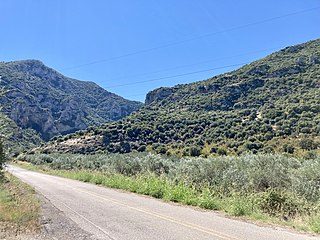 W
WHeraclea (Herakleia) in Trachis, also called Heraclea Trachinia, was a colony founded by the Spartans in 426 BC, the sixth year of the Peloponnesian War. It was also a polis (city-state).
 W
WThe Church of the Holy Apostles, also known as the Imperial Polyándreion, was a Greek Eastern Orthodox church in Constantinople, capital of the Eastern Roman Empire. The first structure dates to the 4th century, though future emperors would add to and improve upon it. It was second in size and importance only to the Hagia Sophia among the great churches of the capital. When Constantinople fell to the Ottomans in 1453, the Holy Apostles briefly became the seat of the Ecumenical Patriarch of the Greek Orthodox Church. Three years later the edifice, which was in a dilapidated state, was abandoned by the Patriarch, and the patriarchate was moved to the Pammakaristos Church. In 1461, the church of the Holy Apostles was demolished by the Ottomans to make way for the Fatih Mosque.
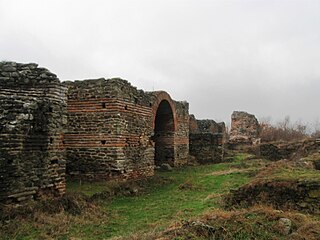 W
WJustiniana Prima was a Byzantine city that existed from 535 to 615, and currently an archaeological site, known as or Caričin Grad, near modern Lebane in southern Serbia. It was founded by Emperor Justinian I (527-565) and served as the metropolitan seat of the Archbishopric of Justiniana Prima, that had jurisdiction over the provinces of the Diocese of Dacia.
 W
WKaninë Castle is a castle in the village Kaninë near Vlorë, in southwestern Albania.
 W
WThe Kasbah of Béja is a historical citadel in the Tunisian city Béja, the Kasbah was built in the 2nd century BC and still exists till today which makes it one of oldest citadels in the region.
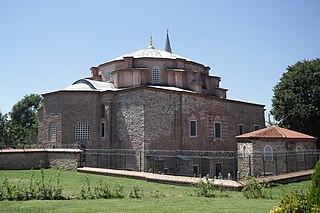 W
WLittle Hagia Sophia Mosque (church), formerly the Church of Saints Sergius and Bacchus, is a former Greek Eastern Orthodox church dedicated to Saints Sergius and Bacchus in Constantinople, built between 532 and 536, and converted into a mosque during the Ottoman Empire.
 W
WLosorion or Lysiris, was a Byzantine (Roman) fortification on the eastern Black Sea coast, in Lazica in what is now Batumi, western Georgia. In 6th century, it was constructed by Byzantine emperor Justinian I, and due to its strategic location became a battleground of the 541–562 Lazic War between Rome and Sasanian Persia (Iran). It was identified with the Medieval fortress of Batumi, known as Tamaris Tsikhe, i.e. Queen Tamar's Castle.Lazica is ours, in which is also the city of the Petraeans, which has taken its civic identity and title from us, using the name of our piety and being called Justiniana. There lie also Archaeopolis and Rhodopolis, very large and ancient forts. With these are also the forts of Scandis and Sarapanis, which we took from the Persians, and Mourisius (Mochiris) and Lysiris (Losorion) and whatever other works we have performed among the Lazi.
 W
WLysimachia was an important Hellenistic Greek town on the north-western extremity of the Thracian Chersonese in the neck where the peninsula joins the mainland in what is now the European part of Turkey, not far from the bay of Melas.
 W
WMarkeli was a medieval Byzantine and Bulgarian frontier stronghold, the ruins of which are located in Karnobat Municipality, Burgas Province, southeastern Bulgaria. Dating to Late Antiquity, the castle lay some 7.5 kilometres from the modern town of Karnobat. It was the site of two notable medieval battles between Byzantines and Bulgarians, the Battle of Marcellae of 756 and the Battle of Marcellae of 792.
 W
WMisis Bridge is a Roman bridge in Adana Province, Turkey.
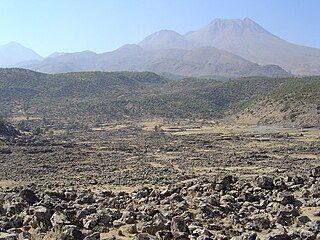 W
WMokissos or Mokisos or Mokison (Μωκισόν) was a town of ancient Cappadocia. The Romans called the city Mocisus or Mocissus, and Mocisum, and after the city was rebuilt by the Byzantine Emperor Justinian (527-565), it was renamed Justinianopolis (Ἰουστινιανούπολις). Justinian made Mocisus the capital of the province of Cappadocia Tertia, and elevated its bishopric to the rank of ecclesiastical metropolis, with an eparchia that stretched south of the Halys River, the longest river of Asia Minor. The name Justinianopolis was retained until the end of Byzantine rule. Stephanus of Byzantium calls the town Moukissos (Μούκισσος). In the Synecdemus, the name appears as Rhegemoukisos (Ῥεγεμουκισός) and Rhegekoukisos (Ῥεγεκουκισός), the later evidently an error.
 W
WThe Patras Fortress was built around the mid-6th century A.D above the ruins of the ancient acropolis of the city of Patras, on a low outlying hill of the Panachaiko Mountain and ca. 800 m from the sea. The castle covers 22,725 m² and consists of a triangular outer wall, strengthened by towers and gates and further protected originally by a moat, and an inner compound on the northeastern corner, also protected by a moat.
 W
WPetra was a fortified town on the eastern Black Sea coast, in Lazica in what is now western Georgia. In the 6th century, under the Byzantine emperor Justinian I, it served as an important Eastern Roman outpost in the Caucasus and, due to its strategic location, became a battleground of the 541–562 Lazic War between Rome and Sasanian Persia (Iran). Mainstream scholarly opinion identifies Petra with a ruined settlement of Late Antiquity at the village of Tsikhisdziri in Adjara, southwestern Georgia.
 W
WPetrelë Castle is a castle in Petrelë, central Albania. Its history dates back to Justinian I. Petrelë Castle is 329 metres (1,079 ft) above sea level.
 W
WQasr Ibn Wardan is a hamlet and 6th-century archaeological site located in the Syrian Desert, approximately 60 kilometres (37 mi) northeast from Hama and about 19 kilometres (12 mi) northeast of al-Hamraa. The hamlet is separated from the Byzantine-era ruins by a road, with the former situated to the east of the road and the ruins situated to the west. According to the Syria Central Bureau of Statistics (CBS), Qasr Ibn Wardan had a population of 467 in the 2004 census.
 W
WRize Castle is a partly-ruined medieval castle located in Rize, northeastern Turkey.
 W
WThe Saint Sofia Church is the oldest church in the Bulgarian capital Sofia, dating to the 4th century. In the predecessor building took place the Council of Serdica held most probably in 343 and attended by 316 bishops. In the 14th century, the church gave its name to the city, previously known as Serdika (Сердика).
 W
WThe Sangarius Bridge or Bridge of Justinian is a late Roman bridge over the river Sakarya in Anatolia, in modern-day Turkey. It was built by the East Roman Emperor Justinian I (527-565 AD) to improve communications between the capital Constantinople and the eastern provinces of his empire. With a remarkable length of 430 m, the bridge was mentioned by several contemporary writers, and has been associated with a supposed project, first proposed by Pliny the Younger to Emperor Trajan, to construct a navigable canal that would bypass the Bosporus.
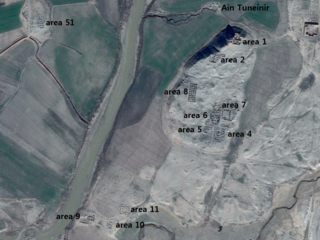 W
WTell Tuneinir is an archaeological site in northeastern Syria. It dates to the early third millennium BC and shows signs of continuous habitation lasting until the beginning of the 15th century AD with epochs during the early Byzantine Empire, when it was known as the city of Thannuris (Thannourios), and during the Ayyubid period.
 W
WThe Trikala Castle is the Byzantine-era citadel of the city of Trikala in western Thessaly, Greece.
 W
WVazelon Monastery is a ruin located in the Black Sea region of Turkey. It was built in AD 270 and is 40 km (25 mi) south of Trabzon. Justinian I, a ruler of the Byzantine Empire, ordered the monastery to be repaired in 565, and it was renovated multiple times until the 20th century. The current structures date from the rebuilding in 1410.